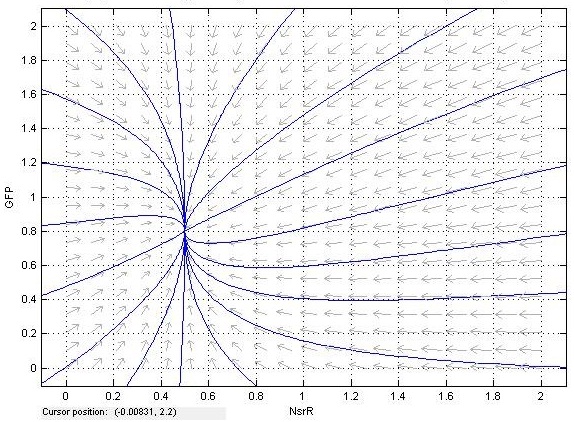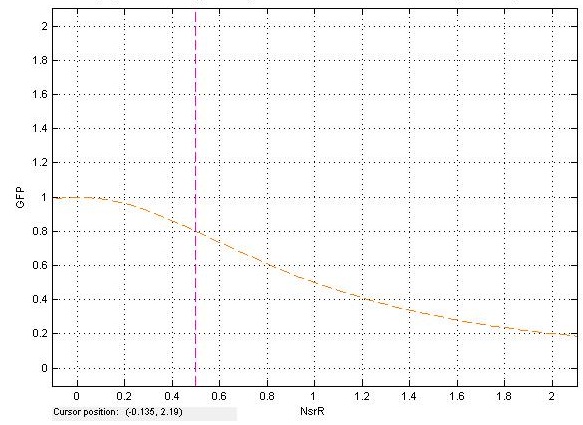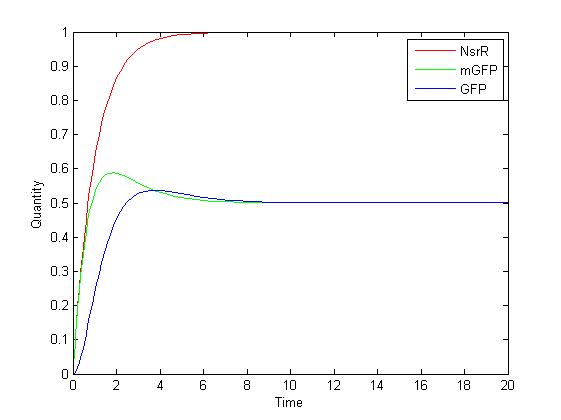Team:BCCS-Bristol/Modelling/GRN/Results
From 2010.igem.org
iGEM 2010
Contents |
Results
Phase Planes
A two-dimensional phase plane diagram is a useful way of showing the dynamics of a system. The phase plane diagrams below show the rate of change of NsrR and GFP given the current quantity of each. This is shown as arrows on a plane, with the direction of the arrow signalling increase or decrease of a variable, and the size of the arrow describing the magnitude of the change. Also plotted on the diagram are level curves (blue). These represent the specific trajectory of some given initial conditions. Level curves are very useful to visualise a range of initial conditions.
This diagram shows that a single stable solution exists, and that all trajectories converge to it eventually. This is unsurprising, as GFP, NsrR and mRNA all break down naturally. Therefore it makes sense that for any fixed production rate of any of these proteins, there will exist some point at which the rate of breakdown matches the rate of production, and the system reaches equilibrium. It is useful to confirm the existence of an equilibrium point mathematically, and locate it as a function of the constants in the equations. This allows predictions to be made about the behaviour of the system over time, avoiding the need for explicit experimental verification.
The diagram above shows the nullclines of the NsrR/ GFP equations. These are lines in phase-space along which the rate of change of one of the variables is zero. The yellow line is for GFP, and the purple line is for NsrR. A point at which nullclines intersect is known as a ‘critical point’. Both lines are dashed, meaning that the trajectories are stable (i.e. all trajectories beginning on the nullcline travel towards our single critical point). Since all nullclines meeting at our only critical point are stable, we can classify the critical point itself as stable. Further, initial conditions starting exactly on the critical point will remain there for all time.
Time Evolution Graph
Using normalized parameters, we plotted the values of our 3 variables over time. This results agrees with our phase plane analysis, as it shows that the system reaches a single equilibrium state and remains there for all time.
Alternative GRN Simulations
Enhancing Precision of Nutrient Measurement
By using two populations of agrEcoli bacteria with differing sensitivity levels, one could theoretically triangulate the expression rates of each population to give a more precise reading of the nutrient levels in soil.
The BSim simulation above shows two agrEcoli populations expressing GFP in response to a non-homogeneous nitrate chemical field. Since one population is more sensitive than the other, it fluoresces faster.
Accelerating detection and signalling
It could be possible to boost sensitivity through quorum sensing. If a bacteria detects the presence of a chemical, instead of just expressing GFP in response, it could also express another intermediate chemical. This could be detected by it's neighbours. If this intermediate chemical also induces GFP expression, this could speed up the total expression rate considerably.
This BSim movie was created using our new Graphical User Interface (GUI). The movie shows two populations of bacteria. The first population, displayed in white, sense the red chemical field and emit a yellow chemical. The second population, initially displayed in blue, sense the presence of the yellow chemical field and respond by changing their colour to green. This movie was develped to test the ability of the new GUI to handle Gene Regulatory Networks (GRNs) and Ordinary Differential Equations (ODEs).
 "
"


